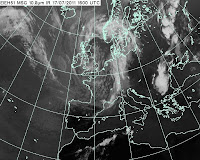Following on from the last post which I discussed the Hadley cell and global circulation within this post im going to touch upon the other two less well known cells the Polar cell and the Ferrell otherwise known as the Mid-latitude cell and also discuss the major wind patterns that exist on earth.
So how do we end up with such stunning scenery as this…
The Polar cell
This cell occurs at 60 degrees north and south. The air has been warmed up and rises upwards, creating a zone of low pressure. Though cool and dry relative to equatorial air, air masses are still sufficiently warm and moist to undergo convection. When the air reaches the polar areas, it has cooled considerably, and descends as a cold, dry high pressure area, moving away from the pole along the surface.The Hadley cell and the Polar cell are similar in that they exist as a direct consequence of surface temperatures. The outflow from the cell creates Rossby Waves, these are ultra-long waves which determine the path of the Jet Stream. By acting as a heat sink, the Polar cell also balances the Hadley cell in the Earth’s energy equation.
I think its worth adding in the diagram of the global circulation in just to recap...
The Ferrel cell
The Ferrel cell occurs between 30 and 60 degrees north and south. The Ferrel cell is dependent for its existence upon the Hadley cell and the Polar cell. It comes about as a result of the the high and low pressure areas of the mid-latitudes. For this reason it is sometimes known as the "zone of mixing." In this cell at higher levels the wind blows equatorward and in a westerly direction and polewards and in an easterly direction on the surface.
So that covers the three cell model for earths global circulation. Although it can be broken down into the three separate cells the majority of the time they can overlap and are certain wind patterns can override the common characteristics of the cells.
If we move from the equator towards the poles we experience a number of different wind patterns. There are three main wind belts which occur as the coriolis force cause the flow to be deflected off the circulation cells.
1) Trade winds (Easterlies): These are mainly associated with the Hadley cell. This wind pattern blows mainly North East in the Northern Hemisphere and South East in the Southern Hemisphere. The Trade winds occur across the equatorial region known as the Inter Tropical Convergence Zone (ITCZ) and when the two Hemisphere winds meet a low pressure area of calm winds form called Doldrums. The trade winds generally cause Cumulus clouds to form and when weaker during the Arctic Oscillation cause more rainfall across North America.
2)
The Prevailing Westerlies: These are mainly associated with the
Ferrel cell. They typically blow from the South West in the Northern Hemisphere and from the North west in the Southern Hemisphere. The Westerlies are strongest when the pressure at the poles are low and weakest when the pressure at the poles is high. They strongly influence the movement of the oceans playing an important role in moving warm waters and winds towards the western coastal regions of continents. When the Westerlies meet the trade winds the Horse latitudes occur which are characterized mainly by light, calm winds.
3) The Polar Easterlies: These are mainly associated with the polar cell. The dry cold prevailing winds blow from the north down to the Westerlies. The southerly flow of air towards the equator is because of the cold air subsiding at the poles. The polar easterlies are generally irregular and weak unlike the other wind patterns. When the Polar Easterlies converge with the westerlies the polar front occurs with similar weather conditions.
Finally as we have discussed the three main circulation cells, the three main wind belts and there are also some main pressure belts across earth:
They are:
1) Equatorial low – A region of low pressure associated with the rising air in the ITCZ. Warm air heated at the equator rises up into the atmosphere leaving a low pressure area underneath. As the air rises, clouds and rain form.
2) Subtropical high – A region of high pressure associated with sinking air in the horse latitudes. Air cools and descends in the subtropics creating areas of high pressure with associated clear skies and low rainfall. The descending air is warm and dry and deserts form in these regions.
3) Subpolar low – A region of low pressure associated with the polar front.
4) Polar high – A high pressure region associated with the cold, dense air of the polar regions.
Classroom tasks:
One task could be for students to draw there own global circulation model drawing on arrows representing wind patterns and include both the pressure bands and the cells. This also could be a good chance for students to present. They could pick one of the cells explaining in detail the patterns of wind and pressure associated with that cell













